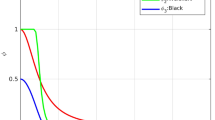Abstract
A closed form solution to the problem of segmenting multiple 3D motion models was proposed from straight-line optical flow. It introduced the multibody line optical flow constraint (MLOFC), a polynomial equation relating motion models and line parameters. The motion models can be obtained analytically as the derivative of the MLOFC at the corresponding line measurement, without knowing the motion model associated with that line. Experiments on real and synthetic sequences were also presented.
Similar content being viewed by others
References
Rittscher J, Tu P H, Krahnstoever N. Simultaneous estimation of segmentation and shape [C]//Proc IEEE Conf Computer Vision and Pattern Recognition. San Diego: IEEE Computer Society Press, 2005: 486–493.
Torr P H S. Geometric motion segmentation and model selection [J]. Phil Trans Royal Society of London A, 1998, 356(1740): 1321–1340.
Feng X, Perona P. Scene segmentation from 3D motion[C]//Proc IEEE Conf Computer Vision and Pattern Recognition. New York, USA: IEEE Computer Society Press, 1998: 225–231.
Torr P, Szeliski R, Anandan P. An integrated bayesian approach to layer extraction from image sequences [J]. IEEE Trans on Pattern Analysis and Machine Intelligence, 2001, 23(3): 297–303.
Vidal R, Ma Y, Sastry S. Generalized principal component analysis (GPCA) [C]//IEEE Conference on Computer Vision and Pattern Recognition. Seattle, USA: IEEE Computer Society Press, 2003: 621–628.
Vidal R, Ma Y. A unified algebraic approach to 2-D and 3-D motion segmentation[C]//European Conference on Computer Vision. Berlin: Springer-Verlag, 2004: 1–15.
Shi F, Wang J, Zhang J, et al. Motion segmentation of multiple translating objects using line correspondences [C]//IEEE Conf Computer Vision and Pattern Recognition. [s.l.]: IEEE Computer Society Press, 2005: 315–320.
Zhang J, Shi F, Liu Y. Motion segmentation by multibody trifocal tensor using line correspondence [C]//International Conf Pattern Recognition. Hongkong, China: IEEE Computer Society, 2006: 599–602.
Faugeras O, Navab N, Deriche R. On the information contained in the motion field of lines and the cooperation between motion and stereo [J]. International Journal of Imaging Systems and Technology, 1990, 2: 356–370.
Jiang S F, Chen Z, Yang S H. Reconstructing 3d rotation motion parameters from 2D image straight-line optical flow [J]. Journal of Nanchang Institute of Aeronautical Technology (Natural Science), 2005, 19(4): 5–8 (in Chinese).
Hartley R, Vidal R. The multibody trifocal tensor: Motion segmentation from 3 perspective views [C]//IEEE Conf Computer Vision and Pattern Recognition. [s.l.]: IEEE Computer Society Press, 2004: 769–775.
Author information
Authors and Affiliations
Corresponding author
Additional information
Foundation item: The National Natural Science Foundation of China (No. 60675017); The National Basic Research Program (973) of China (No. 2006CB303103)
Rights and permissions
About this article
Cite this article
Zhang, J., Shi, Fh., Ma, Wj. et al. A closed form solution to segment 3D motion using straight-line optical flow. J. Shanghai Jiaotong Univ. (Sci. 13, 76–80 (2008). https://doi.org/10.1007/s12204-008-0076-x
Received:
Published:
Issue Date:
DOI: https://doi.org/10.1007/s12204-008-0076-x




